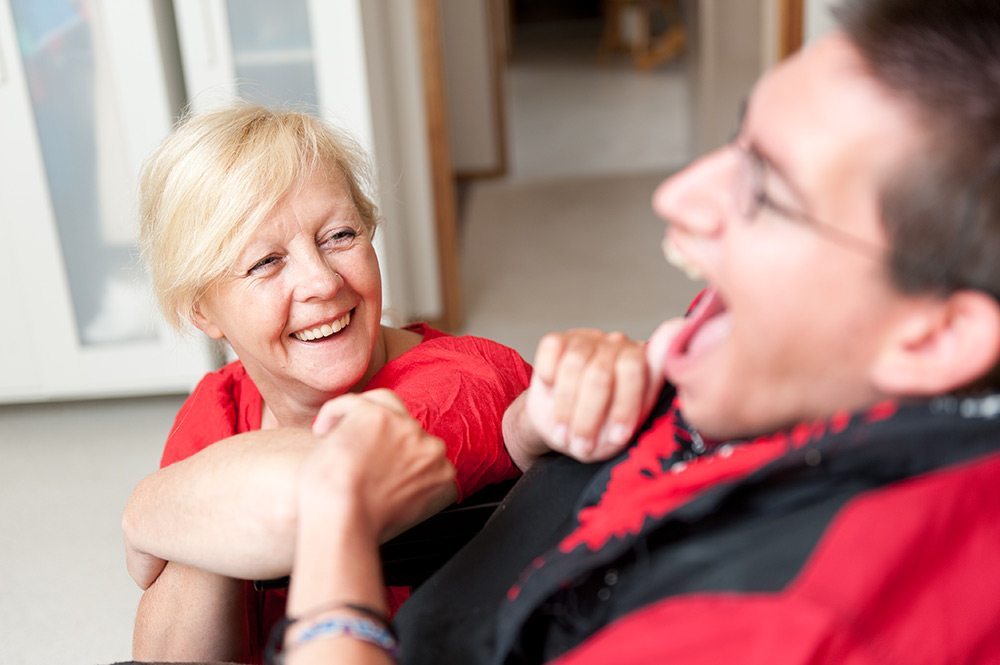Talking to someone with a disability is just like talking to anyone else. But sometimes, you might feel you are saying or doing the wrong thing. We’ve compiled some basic etiquette tips for spending time and communicating with disabled individuals:
General etiquette guidelines
 If you are having a conversation with someone with a disability, it’s a good idea to:
If you are having a conversation with someone with a disability, it’s a good idea to:
- Use the same tone with everyone you talk to. Talk to the individual with a disability the same way you would to someone without a disability.
- If you are introduced to someone with a disability, shake hands as you normally would if the person is able; otherwise you may want to gently touch the person on the arm or shoulder to greet them.
- Talk directly to the person with a disability; communicating about that person to their companion or assistant (if present) can be insulting.
- If you’re not sure what to do in a situation regarding someone with a disability (you feel you’re in their way, you worry you aren’t communicating in the best way, etc.), just ask.
- If you make a mistake or say the wrong thing, apologize and move on.
- Be aware of the social implications of the language you use. For instance, saying that someone is an “inspiration” might not be the best idea, because, as Carlson says, this can “have a negative effect, reminding us how different people still think we are” (2).
- Be friendly and patient! If someone asks for help, help in any way possible.
- Focus on the individual, not on their disability.
What NOT to do when talking to a disabled person
On the other hand, certain actions are considered generally poor etiquette when interacting with someone with a disability. Do NOT:
- Excessively touch the person or their equipment (wheelchairs, canes, etc.). Grabbing or touching someone with a disability is inappropriate and can hinder their movement, balance, or comfort.
- Providing “help” without asking. Assuming someone can’t complete a task on their own can be insulting. According to Tiffany Carlson, a quadriplegic: “We know when to ask for help. Just wait for us to speak up” (2).
- Seek information about the person’s disability unless they offer it. It is not their responsibility to educate you.
Communicating with people with cognitive disabilities
If you’re having a conversation with someone who has a cognitive disability, the following tips may be helpful:
- Be specific without being overly simplistic.
- Listen to the person’s responses so that you can adjust your communication method if necessary.
- Treat adults with cognitive disabilities as you would other adults.
- Repeat yourself when necessary and allow time for the information to be processed.
- Look for cues from the person, but don’t assume they are trying to cut the conversation off if they look distracted. Some people with cognitive disabilities can appear distracted when they are truly listening intently to what you are saying.
- Be flexible, patient, respectful, and supportive.
Communicating with people with speech disabilities
If you’re having a conversation with someone who has a hearing or speech disability, you may want to:
- Ensure that you have the person’s attention before you start to speak (a wave or signal is a good way to establish that you’d like to speak with them).
- Speak clearly and expressively, but do not exaggerate words.
- Speak in a normal tone and at a normal volume unless they request that you speak louder or softer.
- Ask them to repeat or write down sentences if you don’t understand what they are trying to say to you. Don’t pretend to understand if you really don’t. According to Judith Lesner, whose son has speech differences, “If you explain you are having a hard time understanding him, he will not clutch at his heart and fall over in shock… you will not be embarrassing him or yourself by bringing it up. What is not OK is nodding your head with a blank look on your face pretending you are understanding what he is saying” (3).
- Give the person your undivided attention and allow them time to respond to you. Be completely present in the conversation.
- If you are hoping to obtain an answer to a question, try asking it in a way that is easily answered (with a brief answer or a nod). Don’t oversimplify your speech in general, however, because that can be insulting.
When in doubt, ask about their preferences
Each person has different social and communication preferences, so it’s always a good idea to ask them how they would prefer to communicate with you:
- If the person has an interpreter, speak slowly so that he or she can keep up with what you are saying.
- To help them read your lips (if applicable), face the light, keep your hands and other objects away from your mouth, and maintain eye contact.
- Try using sign language if you both know some.
- If they would like you to write words down for them, do it without speaking aloud so that they don’t have to try to read the words and your lips at once.
Sources:
- Disability Etiquette. (n.d.). Retrieved April 18, 2024, from https://www.ucp.org/resource-guide/disability-etiquette/
- Carlson, Tiffany. (2013, July 15). How To Talk To A Person With Disabilities Without Sounding Like An A-Hole. Retrieved April 17, 2024, from https://www.huffingtonpost.com/2013/07/15/disability-etiquette_n_3600181.html
- Lesner, J. (2022, May 10). 4 Tips on How to Talk to My Son With a Speech Difference. Retrieved April 18, 2024, from https://themighty.com/2017/07/how-to-speak-to-my-son-hard-to-understand-cerebral-palsy/

Leave a Reply
You must be logged in to post a comment.